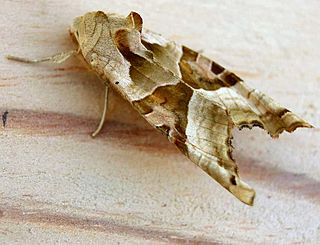
The angle shades is a moth of the family Noctuidae. The species was first described by Carl Linnaeus in his 1758 10th edition of Systema Naturae. It is distributed throughout Europe as far east as the Urals and also in the Azores, in Algeria, and in Asia Minor, Armenia, and Syria. It is strongly migratory.

Apamea remissa, the dusky brocade, is a species of moth of the family Noctuidae. It is distributed throughout Europe and Turkey, ranging across the Palearctic realm to Siberia, Manchuria and Japan. It has also been reported from Alaska.

Apamea sordens, the rustic shoulder-knot or bordered apamea, is a moth of the family Noctuidae. The species was first described by Johann Siegfried Hufnagel in 1766. It is distributed throughout Europe, east across the Palearctic to Central Asia and to China and Japan. It also occurs in North America.

Allophyes oxyacanthae, the green-brindled crescent, is a moth of the family Noctuidae, found in Europe. The species was described by Carl Linnaeus in his landmark 1758 10th edition of Systema Naturae.

Acleris rhombana, the rhomboid tortrix, is a moth of the family Tortricidae. It is found in the Palearctic realm, from Europe to the Caucasus, Armenia, and Turkmenistan.

Catocala nymphagoga, the oak yellow underwing, is a moth of the family Erebidae. It is found in Southern Europe, from Bulgaria up to the Iberian Peninsula and sometimes further north as a migrant. It is also found in North Africa and Asia Minor.

Grammodes stolida, the geometrician, is a moth of the family Erebidae. The species was first described by Johan Christian Fabricius in 1775. It is found in Africa, southern Europe, most of Asia and Australia. It migrates to central and northern Europe as far north as England, Denmark and Finland.

Cosmopterix nishidai is a moth of the family Cosmopterigidae. It is known from Costa Rica.

Mesoligia literosa, the rosy minor, is a moth of the family Noctuidae. The species was first described by Adrian Hardy Haworth in 1809. It is found throughout Europe, North Africa and western Asia. and east across the Palearctic to Siberia.
Dichomeris habrochitona is a moth in the family Gelechiidae. It was described by Walsingham in 1911. It is found in Panama.
Dichomeris squalens is a moth in the family Gelechiidae. It was described by Edward Meyrick in 1914. It is found in Guyana and Brazil.
Dichomeris procyphodes is a moth in the family Gelechiidae. It was described by Edward Meyrick in 1922. It is found in Amazonas, Brazil.
Dichomeris pladarota is a moth in the family Gelechiidae. It was described by Edward Meyrick in 1921. It is found in Zimbabwe.
Dichomeris condylodes is a moth in the family Gelechiidae. It was described by Edward Meyrick in 1921. It is found in Zimbabwe.
Dichomeris rubidula is a moth in the family Gelechiidae. It was described by Edward Meyrick, an amateur entomologist, in 1913. It is found in Mpumalanga, South Africa.
Dichomeris oleata is a moth in the family Gelechiidae. It was described by Edward Meyrick in 1913. It is found in Mpumalanga, South Africa.
Dichomeris instans is a moth in the family Gelechiidae. It was described by Edward Meyrick in 1923. It is found in Peru and Amazonas, Brazil.
Dichomeris cyclospila is a moth in the family Gelechiidae. It was described by Edward Meyrick in 1918. It is found in French Guiana.
Dichomeris stratellus is a moth in the family Gelechiidae. It was described by Walsingham in 1897. It is found in the West Indies and Trinidad.
Dichomeris praevacua is a moth in the family Gelechiidae. It was described by Edward Meyrick in 1922. It is found in Shanghai, China.







